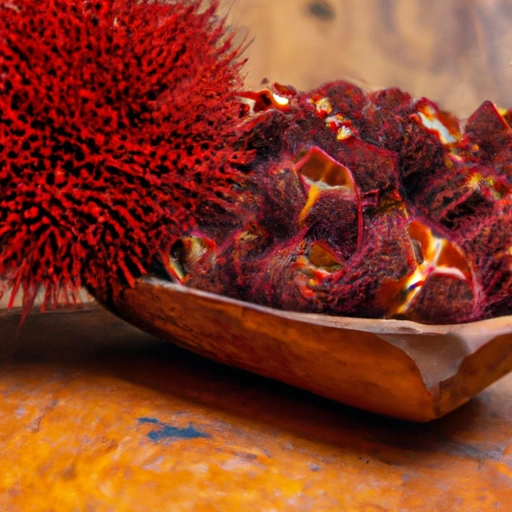Annatto
Description

Annatto is a natural food ingredient derived from the seeds of the achiote tree (Bixa orellana), which is native to tropical regions of the Americas. Known by various names including achiote, bija, and urucum, annatto seeds are encased in spiky bixin pods, which split open when ripe, revealing the vibrant red seeds. Annatto is celebrated for its vibrant color and subtle flavor, which adds depth to a variety of dishes.
Common uses
Annatto is primarily used as a coloring agent in food, providing a yellow to orange hue to a variety of products. It is often used in cheeses such as Cheddar, Red Leicester, and Mimolette to achieve their characteristic color. Annatto can also be found in butter, margarine, rice, smoked fish, and many other food items.
Nutritional value
Calories
In its natural form, annatto seeds contain minimal calories and are used sparingly in recipes. A typical serving size might consist of just a teaspoon (about 5 grams or 0.18 ounces), which would have negligible caloric content.
Protein
Annatto seeds provide a small amount of protein, but as they are used in such small quantities for flavor and color, they do not contribute significantly to the protein content of a dish.
Fat
The seeds are relatively low in fat. Some annatto preparations, such as oils infused with annatto, will have higher fat content depending on the carrier oil used.
Carbohydrates
Annatto seeds contain a trace amount of carbohydrates. However, because they are consumed in such small amounts, their carbohydrate contribution to a diet is minimal.
Vitamins
While annatto seeds do contain some vitamins such as vitamin A, the quantity consumed in a typical serving is too small to have a significant dietary impact.
Minerals
Annatto contains various minerals including calcium, magnesium, and phosphorus, but again, due to the small serving size, these do not provide substantial nutritional benefits in a typical diet.
Health benefits
Annatto is known for its antioxidant properties, thanks to compounds like norbixin and tocotrienols. It may also offer anti-inflammatory benefits and support eye health due to its vitamin A content. However, more research is needed to fully understand the health implications of annatto in the diet.
Potential risks
While annatto is generally considered safe, some individuals may experience allergic reactions or sensitivity to annatto. Those with known sensitivities should avoid annatto-containing products. Excessive consumption is not recommended and may lead to adverse effects.
Common recipes
Annatto is commonly used in Latin American and Caribbean cuisines, featuring in recipes like arroz con pollo, cochinita pibil, and various stews and sauces. It imparts a distinct hue and a hint of nutty, peppery flavor.
Cooking methods
Annatto seeds can be ground into a powder, turned into a paste, or infused into oil or water to color and flavor foods. The cooking method depends on the desired effect and the recipe it is being used in.
Pairing with other ingredients
Annatto pairs well with spices like cumin, chili, and garlic. It complements the flavors of beans, rice, chicken, and seafood. Its mild flavor does not overpower dishes, making it a versatile ingredient in the kitchen.
Summary
Annatto is a versatile food ingredient with a bright color and subtle flavor that enhances a variety of dishes. Although not a significant source of nutrients, it is valued for its coloring properties and potential health benefits. As with any ingredient, it should be used in moderation and with awareness of any individual sensitivities.